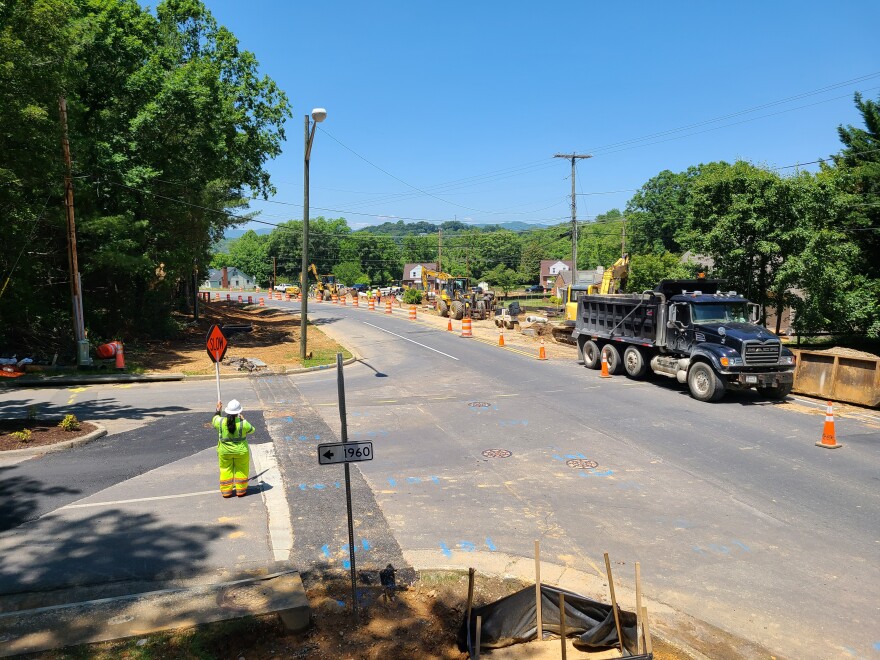If you’re in your car right now, you could very well be sitting at an intersection waiting on the traffic light to change. And you might be thinking, “There’s got to be a better way."
Construction is well under way at the intersection of Starkey and Buck Mountain roads in southwest Roanoke County. And even though the work is only four months into what will be a year-long effort, the project is already beginning to take shape – it’s a roundabout. And it’s a sight that’s becoming more commonplace in communities across the state – and the country.
“If a roundabout is feasible, it is our preferred intersection improvement,” Jason Bond is spokesman for the Virginia Department of Transportation’s Salem District.
“There are many benefits to roundabouts," Bond explains. "We’re talking safety, efficiency, opportunities for beautification – all reasons that people are interested in roundabouts.”
Bond says that while there are many benefits to roundabouts, paramount is safety and improved traffic flow.
“Traffic entering a roundabout slows down and yields to the traffic already inside of the roundabout," Bond says. "That yield-controlled design means that there are fewer stops, less delays, and shorter queues – which improves the efficiency of the intersection.”
Data collected since roundabouts have been put in place in the Salem district, which is comprised of twelve counties, points to a dramatic improvement in safety. Bond sites data from his regions first roundabout at the intersection of Colonial Avenue and Penn Forest Boulevard, completed in 2009.
“For the five years prior to that roundabout being constructed, that intersection had about five crashes each year – and about a third of those were angle crashes, which tend to be the most severe," Bond says. "For the 14 years after the roundabout going in, on average, there’s only been one or two crashes a year, and there has been a reduction in the number of angle crashes that we see at that particular intersection."
While the number of roundabouts increase, if you ask drivers about their attitudes toward them, you’re likely to get a mixed bag of reactions.
“I like roundabouts as a driver because you only need to look kind of to the left,” says Jonathan Stanton, who works for the Roanoke Valley – Allegheny Regional Commission as a transportation planner. But he also appreciates roundabouts as a driver.
“I like that you can keep moving if the traffic is smooth and you don’t need to come to a full stop," Stanton explains. "And it feels like you’re getting through quite easily.”
Jonathan isn’t only a transportation planner, he also a cycling enthusiast – and as a cyclist, he has found roundabouts to be biker-friendly.
“I have the most experience with the Colonial Avenue roundabouts. I quite like them," he says. "It slows cars down to my speed, so it feels safer to ride with traffic.”
At Roanoke’s South County Library – which has its entrance directly off a roundabout, I met Geneva Boggs, who had just dropped off several books and was leaving with an armful of fresh titles. She confessed that she’s not yet a fan.
“Sometimes I think they’re a nuisance,” Boggs says.
When I asked her why she doesn’t like them, she said she has misgivings of dealing with other drivers.
“Yeah, I’m worried about whether this guy who’s coming around this way," she says. "Maybe – does he have the right-of-way? Or do I have the right-of-way?”
While Boggs may not enjoy navigating the roundabouts, she concedes they’re a lot more aesthetically pleasing than another traffic light intersection.
“Yes, they do look nicer,' Boggs admits. "I’ll give them credit for that!”
VDOT’s Jason Bond says communities are now asking for roundabouts – and over time they will continue to gain acceptance.
“With any new traffic pattern or change, there is always an adjustment period," Bond says. "But for a roundabout, if people will really use caution, pay attention to the signage, yield to the oncoming traffic in the roundabout, over time they’ll become more accustomed to it and see some of those benefits.”


